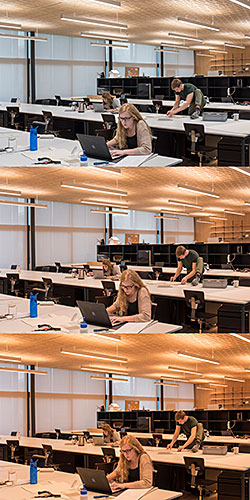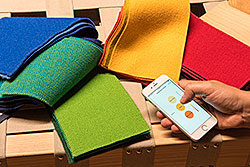Seen in the best light
Tunable white lighting for budding interior designers
Dornbirn, August 7, 2018 – “Tunable White? – we’ve already got it!” That’s the proud boast of the Lucerne School of Engineering & Architecture. There were several good reasons why the School became an early adopter of the new lighting technology with which the luminous flux and the colour temperature of the light can be changed to suit demand. The Tunable White lighting was installed in the Interior Design Studio. Thanks to appropriate LED light engines and associated control technology from Tridonic, the colour temperature of the LED luminaires can be smoothly adjusted between 3,000 kelvin (warm white) and 6,000 kelvin (cool white). Preprogrammed colour temperature curves can also be selected and run.
From too little light to dynamic light
Eight years ago the School of Engineering & Architecture at the University of Lucerne set up a course in interior design and had a studio building constructed specifically for the purpose. With its 70 workstations, a large presentation area and an impressive collection of material, the building provides ideal facilities for project work, modelling and lectures. There was just one problem, however. The illuminance from the luminaires was too low for the demanding work in the studio and had to be replaced. “It quickly became clear to us that we could use the situation as an opportunity to install innovative pioneering lighting”, explained Professor Björn Schrader, senior lecturer and head of the interdisciplinary Licht@hslu platform at the Lucerne School of Engineering & Architecture.
Tunable White for Human Centric Lighting
It was not difficult to convince the Facility Management of the University of Lucerne about the merits of a tunable white solution because the university is constantly having to address the question of optimum lighting for the various rooms and areas at its various premises. “In recent times we have received an increasing number of research requests on this subject. This was a good chance to set up a pilot system”, he added. The requests relate primarily to the possibility of using Tunable White in connection with human centric lighting. This involves simulating the changes in natural daylight using changes in colour temperatures and illuminance levels in order to boost the well-being of the people using the rooms.
The Interior Design Studio is now being used for studies that can be integrated in the students’ normal timetable and their typical activities such as lectures, coaching sessions and creative work. The colour and intensity of the light can be individually adjusted at any time, or they can change gradually and automatically throughout the day in a preprogrammed sequence that can be activated at the touch of a button.
Light as a teaching tool
Lighting solutions with tunable white functionality will feature in many areas of application in the near future. Thanks to the system installed in the studio the interior design students can have hands-on experience of the effects that different qualities of light can have on the users of a room. An initial bachelor thesis on “Human Centric Lighting” has been produced at the commissioning stage at the Institute for Building Technology and Energy. For the budding interior designers a knowledge of the visual effects of different light spectrums, in other words an appreciation of the interplay between light, colour and texture, is absolutely indispensable. The samples from the material collection in the studio and the models produced by the students themselves can be investigated under different lighting conditions in terms of the atmosphere created and the overall effect of the room. This process is a valuable method for expanding the students’ skills and an important didactic element within the bachelor course.
Technology under the ceiling
Linear pendant luminaires were chosen to provide the illumination in the studio. Swiss luminaire manufacturer MOOS licht ag slightly modified a standard luminaire by adding an indirect component to the luminaire’s direct lighting in order to emphasize the effect of the spatial effect. The 32 luminaires are equipped with Tridonic’s linear LED light engines (LLE) with tunable white functionality. Measuring 24 x 280 mm they deliver up to 3,500 or 6,000 lumen depending on type. Tridonic offers the LED modules together with the associated LED driver as a precalibrated PRE KIT. This ensures colour consistency among the LED modules and high quality of light across the entire colour temperature range from 3,000 to 6,000 Kelvin.
The kits are impressive for their colour rendering index of Ra > 90, fine LED binning (MacAdam 3) and the absolute stability of the selected colour temperature throughout the dimming range from 100 % to 10 %. The most recently launched second generation Tunable White LLE PRE KITs can even be dimmed from 100 % to 3 %, exclusively through amplitude modulation. The drivers comply with the IEEE1789:2015 standard and avoid disturbing flicker phenomena. The colour location that has been precisely defined in the kits is retained at all dimming levels thanks to the use of DALI Device Type 8.
Technology in the switching cabinet
The basis for tunable white is the combination of warm white and cool white LEDs, with their light mixed in different proportions. Smart LED drivers with a digital interface are used to vary the proportions of the luminous fluxes from the two types of LED and still be able to dim the overall luminous flux. In this case, Device Type 8 DALI drivers are used. They receive their control commands from Tridonic’s connecDIM Gateway which forms the powerful interface between the DALI universe and the internet (TCP/IP). This means that switching and control commands can be sent from appropriate apps on PCs and mobile devices. The connecDIM Gateway then forwards these commands to the relevant address as DALI commands. There are also apps for PCs and tablets for configuring the lighting system and programming lighting scenes. Alternatively, connecDIM offers a cloud-based web interface.
The lighting in the Interior Design Studio can also be operated conventionally. Standard pushbutton switches have been incorporated via two DALI XC control modules each with four freely programmable inputs. The system can be expanded at any time with actuators and sensors to provide additional lighting functions. Space for sensors is already reserved in the luminaires.
The project
- Renovation of the Interior Design Studio at the Lucerne School of Engineering & Architecture
- Client: University of Lucerne
- Lighting design: Björn Schrader and Anina Bigler, both from the Lucerne School of Engineering & Architecture
- Luminaires: MOOS licht ag, Lucerne
- Tridonic products used: Linear Tunable White System LLE 24 x 280 mm PRE KIT – adjustable colour temperature from 3,000 to 6,000 K at constant luminous flux, precalibrated kits to ensure quality of light and colour consistency, consisting of an LED driver and four or five LED modules (a total of 32 luminaires: indirect 32 x LLE 24x280mm 5x700lm 930-960 PRE KIT, direct 64 x LLE 24x280mm 4x1500lm 930-960 PRE KIT; plus two reserve luminaires: indirect 2 x LLE 24x280mm 5x700lm 930-960 PRE KIT, direct 4 x LLE 24x280mm 4x1500lm 930-960 PRE KIT)
- Light management solution: connecDIM Gateway G1 Ethernet TCP/IP to DALI (lighting control for up to 256 DALI devices on four DALI lines), DALI Interface RS232 PS/S (PC interface module for DALI systems), DALI XC control module
- Photos: Thomas Mayer
Press contact:

Tridonic GmbH & Co KG
Färbergasse 15
6851 Dornbirn, Austria
Tel. +43 5572 395-45236
Mobile +43 664 80892 6313



